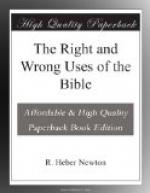To see this second section of Isaiah aright, we must push it down the stream of time nearly two hundred years. It is the work of a prophet, or group of prophets, in the latter part of the exile, about the middle of the sixth century before Christ. Watching the signs of the times, the gifted and gracious spirit who led this chorus of hope saw tokens, as of the dawning of day after the long, dark night. Rumors of the all conquering Cyrus, the Medo-Persian king, made Babylon tremble with fear, and Israel thrill with excited expectation. In the ethical and spiritual religion of the advancing Persians, the Jews might look for a bond of sympathy. It would be the policy of Cyrus to make friends of the foes of Babylon, and to place the captive people in their own land on the borders of his empire, as his grateful feudatories. The seer saw thus, in the conquering hero, the Servant of God, raised up to restore the chosen people to their native country. Prophecy kindled anew for its final flame, and burst forth in the immortal strain of hope for the long-tried Israel:
Comfort ye, comfort ye my
people,
Saith your God.
Speak ye comfortably to Jerusalem,
and cry unto her,
That her warfare is accomplished,
That her iniquity is pardoned.
I never read this sublime chapter without a fresh thrill, as I hear the voice of a crushed race, lifting amid its misery a cry of unconquerable confidence in the Just and Holy One, who was ordering alike the embattled armies of earth and the starry hosts of the skies, and through history, as in nature, was sweeping on resistlessly to fulfill the good pleasure of His Will. No wonder the matchless oratorio of the Messiah opens with this aria, abruptly as the original words are spoken in Isaiah. They sound the key-note of the good tidings of great joy which, growing as a hope in men’s souls through the centuries, became a faith, an assured conviction, in the life of the Christus Consolator; in whom God is seen as “Our Father which art in heaven.”
Every gem of this second section of Isaiah takes on a new lustre in this setting. It is the cry of the lost sheep in the wilderness, catching sight of the Shepherd who they thought had forgotten them, that we hear in the gracious strain:
He shall feed his flock like
a Shepherd,
He shall gather the lambs
with his arm,
And carry them in his bosom,
And shall gently lead those
that are with young.
The vision of the Suffering, Righteous Servant of God grows clear and pathetic in the true historic light. The chastened nation feels itself called to a higher mission than that of political power. It is to teach the other nations of the earth the knowledge of God. That knowledge it is itself to learn in the school of sorrow. It is to save humanity through the sacrifice of itself. Thus the secret of suffering is spelled out, not for ancient Israel alone, but for all mankind; the secret which is shrined, for ever sacred to us, in the story of our Lord Christ; from whom you and I this day, through a simple symbol, are to learn anew that if we sorrow it is that we may be made perfect through suffering, and thus be fitted to lead our fellows up into the light and love of God.




